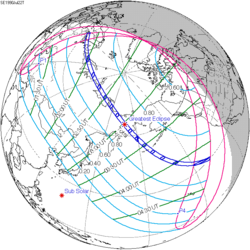| Total eclipse | |
| Gamma | 0.2894 |
|---|---|
| Magnitude | 1.0458 |
| Maximum eclipse | |
| Duration | 249 s (4 min 9 s) |
| Coordinates | 16°06′N22°12′E / 16.1°N 22.2°E |
| Max. width of band | 159 km (99 mi) |
| Times (UTC) | |
| Greatest eclipse | 10:18:45 |
| References | |
| Saros | 130 (53 of 73) |
| Catalog # (SE5000) | 9583 |
A total solar eclipse will occur at the Moon's descending node of orbit on Monday, March 20, 2034, [1] with a magnitude of 1.0458. A solar eclipse occurs when the Moon passes between Earth and the Sun, thereby totally or partly obscuring the image of the Sun for a viewer on Earth. A total solar eclipse occurs when the Moon's apparent diameter is larger than the Sun's, blocking all direct sunlight, turning day into darkness. Totality occurs in a narrow path across Earth's surface, with the partial solar eclipse visible over a surrounding region thousands of kilometres wide. Occurring about 1.3 days before perigee (on March 21, 2034, at 18:15 UTC), the Moon's apparent diameter will be larger. [2]
Contents
- Images
- Eclipse timing
- Places experiencing total eclipse
- Places experiencing partial eclipse
- Eclipse details
- Eclipse season
- Related eclipses
- Eclipses in 2034
- Metonic
- Tzolkinex
- Half-Saros
- Tritos
- Solar Saros 130
- Inex
- Triad
- Solar eclipses of 2033–2036
- Saros 130
- Metonic series
- Tritos series
- Inex series
- References
- External links
Totality will be visible from the extreme southern tip of Benin, Nigeria, northern Cameroon, Chad, Sudan, Egypt, Saudi Arabia, Kuwait, Iran, Afghanistan, Pakistan, northern India, and western China. [3] A partial eclipse will be visible for parts of eastern Brazil, Africa, Europe, the Middle East, Central Asia, and South Asia. Coincidentally, The eclipse passes through many Islamic countries around the date of Islamic New Year (estimated around March 20–21 according to local traditions, time zone and atmospheric conditions), and also passes through Iran only a few hours before the vernal equinox, marking the beginning of the Persian New Year. Since the Islamic lunar year is 11–12 days shorter than the solar year that the Iranian calendar observes, the Islamic New Year rotates through the seasons of the year, while the Persian one is on nearly fixed date on Gregorian calendar. It is an extremely rare case that the two new years meet.






































































































